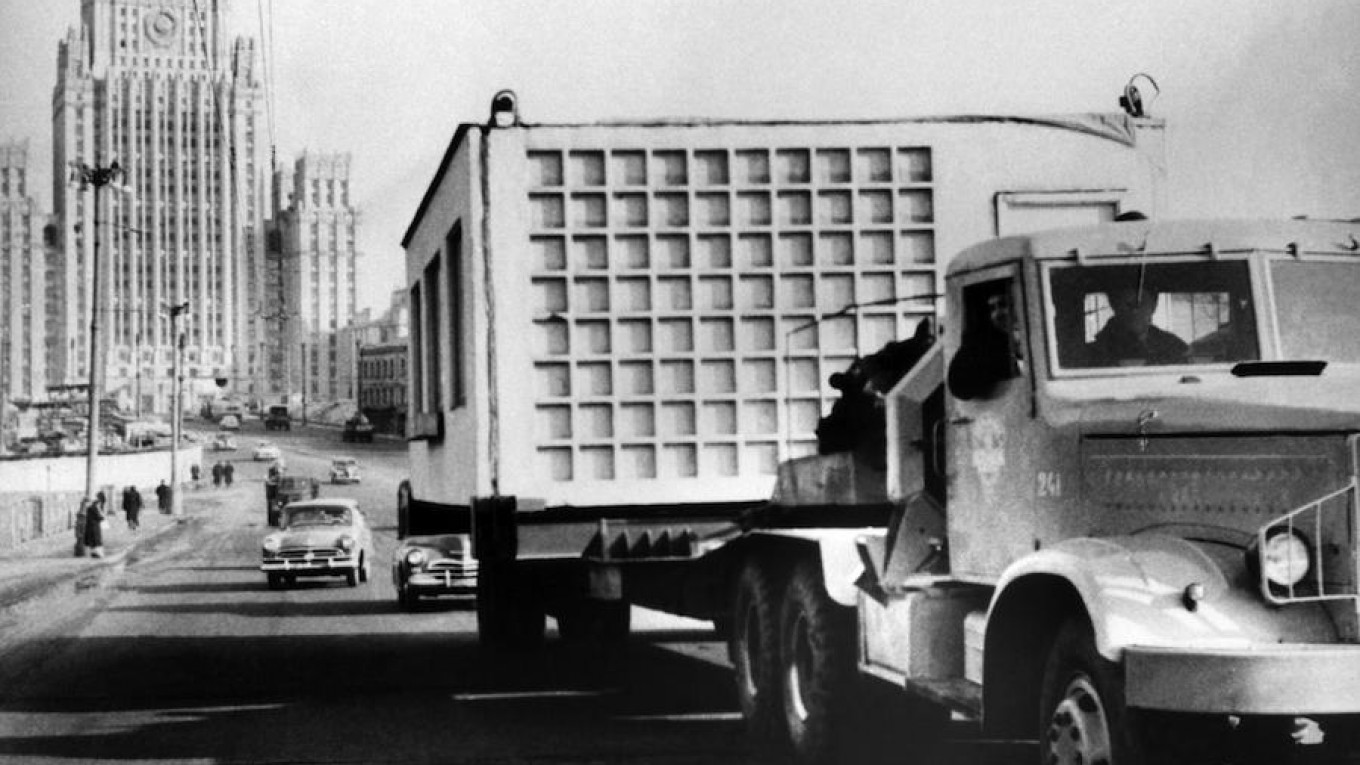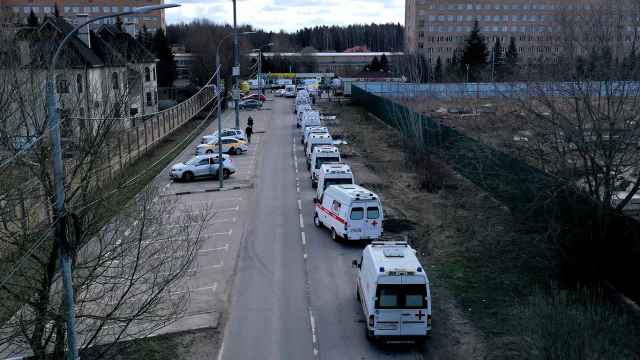Up to 1.6 million Muscovites live in worn-out dwellings that are beyond repair, the mayor of Moscow Sergey Sobyanin told President Vladimir Putin during their televised meeting on Feb, 21. “Well, these buildings have to be razed and new housing has to be built instead,” Putin suggested matter-of-factly, as if the two men were discussing Sobyanin’s old dacha.
The buildings in question, five-story prefabricated apartment blocks built under Nikita Khrushchev 50 to 60 years ago, have long outlived their temporary status. They were never meant to serve this long.
The problems are, first, they are incredibly numerous, and second, they were constructed by a socialist state within a legal environment strikingly different from today’s. Even in Russia people have private property rights these days.
But before getting into the predicament of a politician tasked with redirecting a path beaten by generations of his predecessors, we need to understand the importance of the path.
In 1956–57 the Soviet architect Nathan Osterman with a number of associates built an experimental quarter of apartment blocks in Moscow’s South West district. The newly created locality of Cheryomushki had some brick houses, some pre-engineered houses, and some prefabricated large-panel ones, most of them austere five-level blocks devoid of any décor or balconies.
They were standing amid green fields still dotted by villages at the time. Today this part of the city is considered one of the most prestigious and expensive; it feels central and boasts good schools.
Back in 1956, it was a project of national importance for a country of 200 million inhabitants, most of whom had nowhere to live. The United States probably never experienced a housing crisis of such proportions. Postwar Europe knew it to a certain degree.
But the Soviet Union of the 1940s and 1950s was different. It was a place where the consequences of breakneck industrialization, stepped-up urbanization, and a brutal war collided to produce a massive shortage not just of housing but of any sort of shelter.
Though the 1917 revolution was unleashed in a predominantly rural country, with just 15 percent of the population living in cities, the Soviet Union of the second half of the 1950s was on the cusp of becoming an urbanized society.
Fifty percent of the population were urban dwellers by 1960. Moscow alone expanded by a factor of three to four, depending on which year is taken as a starting point, 1917 or 1920, when Moscow shrank from 1.8 million to 1 million. At any rate, in the late 1950s a Moscow with 5 million population had to make do with the amount of housing meant for fewer than 2 million.
Growth by a factor of 10 was not unusual: both Ekaterinburg and Novosibirsk grew 10 times between 1917 and the late 1950s. And yet only a limited number of “socialist dwellings” were built for factory workers and engineers during the 1930s and 1940s.
Underfunding, severe shortages of construction supplies and a lack of political will to tackle as petit bourgeois a subject as housing all contributed to creating a human catastrophe that Nikita Khrushchev inherited from Joseph Stalin.
District 9 of Сheryomushki became a template for the kind of development Khrushchev decided to use to alleviate the problem. So-called “mikrorayony” (microdistricts, or neighborhood units designed to house tens of thousands of inhabitants each) were reproduced throughout the Soviet Union. The vast majority of Russians — this writer included — grew up in such a microdistrict. Microdistricts would normally have green spaces, apartment buildings scattered at 50 to 200 meters’ distance from each other, a metro station somewhere in the vicinity, and most amenities within walking distance.
It would have made for a beautiful living if the apartment buildings had been a little nicer and if the shops had had better food—or sometimes any food at all. But we loved it anyway. We did not have much to compare it to. And, of course, we valued the clean air, the walks in the woods, the skiing in winter, the cycling in summer.
Originally these neighborhoods were filled with prefabricated five-story apartment blocks. In the late 1960s nine-story to 16-story similarly prefabricated high-rises were introduced to accommodate more people within the same microdistrict scheme.
Developments of this type cover up to 80 percent of the urban areas in the former Soviet space. Razing and redesigning it all is a truly unthinkable effort that is not even being considered. Only Moscow can afford to address the problem, and it can only afford to address it in part.
A lot of the Soviet-built housing is in precarious shape. The apartment buildings that are planned to be demolished in Moscow are mostly the five-story ones that are long past their originally designated life span of 25 years. Despite an earlier and much smaller program of demolition, the bulk of them are still standing.
The plan is to raze and build at least 25 million square meters’ worth of housing. This is a lot. This is more than 10 percent of Moscow’s entire housing stock; 1.6 million people live there. It took the Soviet building industry (and it could work fast) about 10 years to build this much.
The plan is indeed an ambitious one, to put it mildly. Many have explained the conspicuous meeting between Putin and Sobyanin, the mayor, as a staged preelection routine. Many have said that a huge building project like this would be a bonanza for the construction firms owned by the mayor’s cronies.
The truth is, one does not need to rebuild one-tenth of Russia’s biggest city to win an election in Russia. As things stand right now, there is no opposition that could pose a credible challenge to Putin or Sobyanin. The Kremlin has seen to that.
The project would take more than 10 years, probably decades, and would be incredibly costly. The range that is quoted now is between 4 trillion rubles ($68 billion) and 6 trillion ($103 billion). At this very preliminary stage, the figures are just abstractions and are probably too low.
What this story really means to me is that today’s Russia is hostage to Soviet policies. Even if Moscow were able to humanize its housing, most of Russia simply would not be able to afford it. We will have to wait until all the prefab blocks just gradually disintegrate and make room for something that our children will come up with.
Maxim Trudolyubov is a senior fellow with the Kennan Institute. This Op-Ed originally appeared on The Russian File. A Kennan Institute Blog.
A Message from The Moscow Times:
Dear readers,
We are facing unprecedented challenges. Russia's Prosecutor General's Office has designated The Moscow Times as an "undesirable" organization, criminalizing our work and putting our staff at risk of prosecution. This follows our earlier unjust labeling as a "foreign agent."
These actions are direct attempts to silence independent journalism in Russia. The authorities claim our work "discredits the decisions of the Russian leadership." We see things differently: we strive to provide accurate, unbiased reporting on Russia.
We, the journalists of The Moscow Times, refuse to be silenced. But to continue our work, we need your help.
Your support, no matter how small, makes a world of difference. If you can, please support us monthly starting from just $2. It's quick to set up, and every contribution makes a significant impact.
By supporting The Moscow Times, you're defending open, independent journalism in the face of repression. Thank you for standing with us.
Remind me later.







